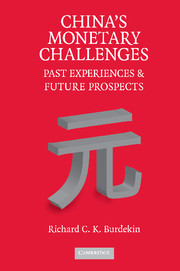Book contents
- Frontmatter
- Contents
- Preface
- Introduction: China Today and Lessons from the Past
- PART I CHINA'S EXCHANGE RATE REGIME AND MONETARY POLICY
- 1 The Renminbi–US Dollar Exchange Rate Controversy
- 2 China's Reserve Buildup and Global Imbalances
- 3 Combatting Inflation and Deflation
- 4 People's Bank of China Policymaking and External Pressures
- PART II THE IMPORTANCE OF INTERNATIONAL FACTORS, PAST AND PRESENT
- PART III THE PEOPLE'S REPUBLIC'S ROLE WITHIN GREATER CHINA AND ASIA
- 10 Conclusions and Future Prospects for the Renminbi
- References
- Author Index
- Subject Index
2 - China's Reserve Buildup and Global Imbalances
Published online by Cambridge University Press: 06 July 2010
- Frontmatter
- Contents
- Preface
- Introduction: China Today and Lessons from the Past
- PART I CHINA'S EXCHANGE RATE REGIME AND MONETARY POLICY
- 1 The Renminbi–US Dollar Exchange Rate Controversy
- 2 China's Reserve Buildup and Global Imbalances
- 3 Combatting Inflation and Deflation
- 4 People's Bank of China Policymaking and External Pressures
- PART II THE IMPORTANCE OF INTERNATIONAL FACTORS, PAST AND PRESENT
- PART III THE PEOPLE'S REPUBLIC'S ROLE WITHIN GREATER CHINA AND ASIA
- 10 Conclusions and Future Prospects for the Renminbi
- References
- Author Index
- Subject Index
Summary
[The International Monetary] Fund should focus its surveillance on the systematically important countries issuing major reserve currencies. The frequent outbreak of crises since the collapse of the Bretton Woods system indicates that the fundamental weakness of the international monetary system lies in its undue reliance on a single currency.
(Zhou Xiaochuan, Governor of the People's Bank of China, 2006b, p. 4)Introduction
The upward pressure on the renminbi in the early twenty-first century arose in the midst of generalized dollar weakness. Sharp interest rate reductions by the US Federal Reserve after September 11, 2001, coupled with mushrooming US current account deficits, were met by a decline in the value of the US dollar against most major world currencies from 2002 onwards. Subsequent Federal Reserve rate hikes were insufficient to more than temporarily suspend the dollar downturn in 2005, and dollar depreciation quickly reaccelerated in the face of continued record US trade deficits and new Federal Reserve rate cutting initiated in the second half of 2007. Whereas a past major devaluation of the dollar in 1933–1934 has itself been seen as a key policy shift that permitted sufficient monetary expansion to reverse deflation pressures in the 1930s (Bernanke, 2002), its impact is remembered more negatively in China – where it put great pressure on the economy and induced a monetary regime change that facilitated an ultimately disastrous inflationary spiral (see Chapter 5). Dollar depreciation is certainly not an official goal today.
- Type
- Chapter
- Information
- China's Monetary ChallengesPast Experiences and Future Prospects, pp. 33 - 54Publisher: Cambridge University PressPrint publication year: 2008



